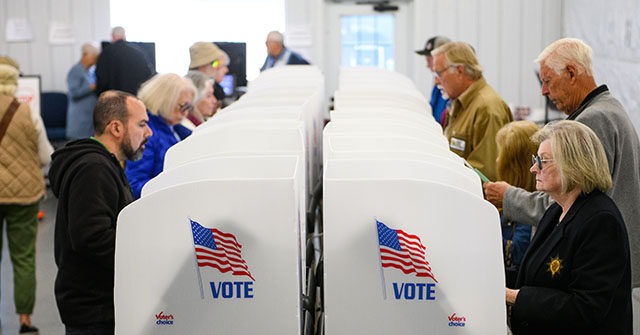
The 2024 election is shaping up to be a photo finish according to polling and voting data streaming in from a variety of places. Some people are making predictions one way or the other, suggesting they have insight on whether former President Donald Trump will pull off the greatest comeback in American political history or whether Vice President Kamala Harris will pull off an unprecedented victory after her late entrance into the race when her boss, President Joe Biden, dropped out.
It all comes down to who votes, which party turns out their people, and which theory of the case is right. I’m not going to make a prediction as I think those are useless. But I will do here is lay out what I think the landscape looks like and a compelling theory of the case explaining what I’ve been looking at in the final weeks and will be looking at in the final two days of this election. The answer to the question of which theory is correct we will find out on Tuesday night.
I’m inevitably asked by basically everybody in the lead-up to an election what I think will happen. People who work in the business, and people who just tune in in the final days, everyone who knows me knows this is not my first rodeo with presidential elections. I’ve covered many of them–this is my third one at Breitbart News, and it’s my fourth one working in the news business. I’ve also covered many more midterms, special elections, and off-year elections as well. And people know I obsess over data, from polls and voting patterns, trying to get ahead of the curve on demographic swings or changes that might be coming. My track record is pretty good, I’d argue, especially when it comes to seeing stuff others miss–most notably of course the 2016 election, but also key stuff in 2014, 2018, 2020, 2021, 2022, and more. I’m also in constant contact with similar folks on both sides of the aisle trying to decipher headwinds, and talk to the various campaign and outside group folks and have a generally good idea of where to get reliable information and where to apply some healthy skepticism.
I don’t like happy talk from either side, and I try to make sense of what’s actually going to happen rather than providing a biased or slanted view. When election night comes and goes, of course, reality will set in no matter what–and someone has to win, and someone has to lose. The biggest question I always inevitably get after 2016 and 2020 both saw major polling industry misses is whether or not that’s going to happen again. There’s a lot of reason to believe it will, but we won’t know for sure until the votes are counted. So what I’m going to do here is something a little bit different than I normally do in news coverage. I’m going to lay the landscape as I see it now and what I expect and am looking for to figure out whose theory of the case is correct–and yes, as you’ve probably already noticed, I’m very much using first person here which is abnormal for me. Please, I beg readers and observers: Hold me to this case when the election is over. While I’m not making a prediction on who ultimately will win, I obviously want Trump to pull it off–I’ve said so publicly and even told the former president when I interviewed him in mid-October I was voting for him myself–and I can see a clear pathway for him to be able to do so. But there’s also a clear case to be made the other way, and yes I hate hedgers but that’s what I’m doing here–hedging, because while there are indeed lots of good signs for Trump that’s what they are: signs. Nobody knows exactly what will happen until it happens, and anyone who claims they can see the future is dead wrong: As far as I can tell, that superpower does not exist in humans at least not yet.
The Landscape on the Final Weekend:
First off, let’s lay out the status of the race as we open Sunday morning two days before election day. On Saturday night, the establishment media gushed over a poll from the Des Moines Register’s vaunted pollster Ann Selzer–she is revered by the political class, seen as an oracle of things to come–that showed Harris leading Trump in Iowa by 3 percent. This came after an Emerson College poll released earlier in the evening in Iowa showed Trump up double digits, and outperforming his 2020 victory margins over Biden there. So this presents us with an interesting question: Which one is right? Both things probably cannot be true except at the most extreme edges of the two surveys’ margins of error, as Nate Silver explained in a column late Saturday evening.
There are a lot of really, really smart people who know Iowa politics really well who think Selzer swung and missed bad:
Shortly after Selzer released her Iowa survey, AtlasIntel released a national poll and battleground state polls. Trump, the Atlas polls show, leads every single battleground state:
Atlas also had Trump up nationally:
Two wildly different worldviews right? While Atlas did not poll Iowa, if Selzer’s theory of the case is correct, there’s no way Atlas’s theory can be right–plenty of folks have rightly pointed out that if Trump has collapsed in Iowa then he probably is in trouble in neighboring Wisconsin too, not leading by more than a percent.
On Sunday morning, more polls came out. An Emerson College national survey shows a tied race nationally at 49 percent for Trump and for Harris:
In the electoral college, this would probably mean a Trump sweep across the battleground states or close to it. In 2016, Democrat Hillary Clinton won the national popular vote by more than two and a half points but lost the electoral college–and in 2020 Biden won the national popular vote by more than four and a half points and barely won the electoral college. Those are not the only national polls out on Sunday morning. NBC News released one that shows Trump up a percent on Harris in the full field with third party candidates included while the two are tied head-to-head:
But then ABC News released one that shows Harris up 3 percent nationally in the full field:
Then there are New York Times polls from Sunday morning across the battleground states as well that paint an interesting and mixed picture of where things stand. The Times has Trump clearly up in Arizona, Harris barely up in North Carolina, Georgia, Wisconsin, and Nevada, and a tie ballgame in Pennsylvania and Michigan:
So how does that reconcile with AtlasIntel from the night before? Which one is right? We’ll find out on election night for sure, which is not far away. But interestingly, the New York Times’s Nate Cohn–one of the smartest data guys out there–writes a heck of a caveat in his piece releasing this data on Sunday morning suggesting he thinks it’s certainly possible perhaps even likely that the polls yet again underestimate Trump in a big way:
You can scour the polls over the past few weeks and find similar discrepancies from pollster to pollster, some of them wide and some of them minor but enough to make the difference. But the point is: How do you read this incoming data deluge and make sense of it all? As Silver’s headline on the Selzer poll release makes clear, “somebody is going to be wrong.” The question then that must be answered is: Who will be wrong and why? Well, the Trump team very much thinks the people who are going to be wrong will be the same folks across the political establishment–the media, the pundits, the pollsters, et cetera–who were wrong in both 2016 and 2020. And they have a lot of good reason to think so. But it’s also possible, sure, that things are wrong the other way. We’ll of course find out which case is correct and which one is not in a couple days. But here’s a big piece explaining the data that we do have in public at this point and why there’s a lot of reason to believe that Trump’s theory of the case is right yet again. For whatever it’s worth, his very future–in addition of course to the future of the nation and the world–depends on it. If he loses, the legal cases against him will accelerate next year–but if he wins the law-fare collapses. So there’s a lot on the line here.
Betting Market Jitters Rattle Final Days
Another place to look for signs–less scientific, and more based on the gut of the people with actual money on the line because they are literally betting on the outcome like sports bettors–is the betting markets. For the last few weeks, Trump had been clearly and convincingly the favorite in the betting markets. The three major ones to watch are Polymarket, Kalshi, and PredictIt. Trump was a double digit or close to it favorite in all of them, and in most of the battleground states too. The markets have been rattled by things this weekend like the Selzer poll and in the lead-up to it clearly by an orchestrated leak from the Harris campaign’s senior-most adviser David Plouffe who claimed without evidence late last week that late-breaking undecided voters were going double digits for Harris. There’s really no reason to believe that’s true at least not to that extent, but the betting markets tend to be jittery especially when big “whales” make massive bets.
The markets have been remarkably consistent until this final weekend, though:
Some whales have been making huge bets throughout the election:
And there is wild movement in some of the key states in the final days:
The betting markets are not and really have never been the best indicators of outcomes; they do occasionally show at least some perceived movement for one candidate or against another. But in terms of predictive value, they really do not suggest much. The most extreme swings I can remember in betting markets were in the 2022 Pennsylvania GOP U.S. Senate primary, where polling showed Dr. Mehmet Oz way out front and businessman David McCormick in distant second or perhaps even third place. McCormick was way down going into the election in the betting markets, but when the results started rolling in showing a very close race he shot up to mega favorite somewhere near 90 percent, but then McCormick ended up losing a very close race to Oz by about a thousand votes. The reason I bring that up is because betting markets tend to be very jittery around election time and even as results pour in, and they do not tend to be particularly predictive of outcome–they tend to track with where conventional wisdom is going, not where the results actually go.
Models, Models, Models: Poll Aggregators Try to Decipher Big Picture
In addition to the actual polls and the betting markets, another thing to keep an eye on is the predictions of the various modelers–and yes, just like pollsters, there are many of them. What modelers do is take the aggregates of polling data and try to apply a formula to it to make sense of what might happen.
There are various levels of sophistication in modeling. Some are just polling averages. Others are complicated formulas that apply differing levels of weighting to the publicly available data. The most well-known modeler, and probably the most accurate modeler, is Nate Silver. He used to run FiveThirtyEight before he went off on his own and made his own new model (FiveThirtyEight is still active and is now owned by ABC, and runs its own models too). Then there’s the Economist magazine, and then there is RealClearPolitics.
Silver’s latest model prediction as of Sunday morning is that Trump has a 51.5 percent chance of winning the election, and Harris has a 48.1 percent chance of winning. A tie, or nobody with a majority, gets a 0.4 percent shot in Silver’s analysis (how fitting that would be as an end to this wild election cycle that the two candidates would get 269-269 and the U.S. House would have to decide?). As Silver keeps warning his readers, this is a genuine toss-up if the polls are right–but he also has said in other pieces that it’s certainly possible that the polls are wrong and they might be wrong in a way favoring Trump. But they also could be wrong in a way that favors Harris. Who knows? It’s honestly why we can’t call the election right now because we genuinely do not know how this will break.
Now, if you read Silver’s modeling in a different way like Eric Daugherty does here, it’s possible you could give Trump an even bigger edge in that if you apply his national polling average to his expectations of the electoral college bias favoring Trump, you would get a near certainty that Trump would win:
The latest FiveThirtyEight model is actually kinder to Trump than Silver is as of Sunday (throughout the election Silver’s new model has usually been kinder to Trump than his old outfit):
The Economist model, meanwhile, expects a razor thin outcome that favors Harris:
Meanwhile, RealClearPolitics’s polling averages in the battleground states have Trump leading North Carolina, Georgia, Arizona, Nevada, and Pennsylvania, while Harris leads Michigan and Wisconsin. All of these leads for both sides are miniscule, and none of them are clear and convincing.
Which one of these models or estimates is right, if any of them? Are they all wrong? We’ll find out in two days.
The Analysts: People Who Know What They’re Talking About Weigh In
As far as elections go, every time around you’ll see a bunch of analysts and people who purport to be able to read the tea leaves weighing in on what they think will happen. The most notorious of these is a man named Allan Lichtman, a professor at American University who developed a system decades ago that applies a series of “keys” that have nothing to do with data but with the nature of the nation and the electorate to make a prediction about who will win. Lichtman claims to have gotten all but one of the last several elections right–his prediction in 2000 was Democrat Al Gore would win, and he still clings to hanging chads in Florida to claim he was right after all even though Republican George W. Bush won that election–but there are very well-documented problems with Lichtman’s history and predictions.
Lichtman has formally predicted that Harris, the Democrat, will win this election. He might be right in the end, or he might be wrong, and if he’s right he’ll claim the high ground and if he’s wrong his system will be shredded by critics.
But beyond the panache and flashy nature of Lichtman’s tea-leaves-reading, there are other far more credible analysts who regularly weigh in in the lead-up to an election. Probably the best among the analysts out there is a man named Sean Trende with RealClearPolitics. He did an interview recently with New York Magazine in which he explained he thinks Trump has the edge going into the election, more so than Harris–though he certainly is not yet calling the race or anything like that. Trende told the magazine that “if you look at the bigger picture and everything else surrounding the race — I think to the extent we’re going to rely on vibes, they’re better for Trump.”
“I think Trump’s had a couple rough news cycles since then, but I still think, on balance, once you get past the polls — which, again, point to a very close race — the way I might put it is I’d rather be playing his hand than hers,” Trende said.
To summarize Trende’s argument, there are a few major reasons why he thinks Trump has the edge in the home stretch. The first is the behavior of the campaigns. Put simply, with some exceptions: Trende thinks Trump is acting like a winner, and Harris is acting like a loser. There’s a lot of reason to think that’s true, and even though it kind of blew up on him after the fact the mere fact Trump did his Madison Square Garden rally in the first place is something Trende thinks is the act of a winner not a loser on the GOP side.
But more importantly that that stuff, Trende argues, is some of the trends that are apparent in the substantial amounts of early voting data streaming in from across the country now especially from the battleground states. Trende argues that the early voting data that suggests what the election day “overall numbers” will look like are “really bad for Democrats” as nationally speaking “it really does look like minority turnout is down.” He’s right about that, and we’ll get into it in the next section in an in-depth way. But it’s also worth highlighting another thing that Trende said about Trump in that interview, which is he said: “I do think you have to give some weight to the possibility that the pollsters are going to underestimate him.”
So, if that happens again like it did in 2016 and 2020, depending on how eccentric such an error would be in the polling, it would ultimately suggest a blowout victory for Trump would loom in the electoral college–and all this talk of this being a super “close” election will have been just plain wrong. Is it possible? Yes. Is it likely? Perhaps. Will it definitely happen? We’ll see on Tuesday.
Cohn from the Times, another analyst worth closely watching, had a similarly fascinating piece this weekend headlined: “Why Are Democrats Having Such a Hard Time Beating Trump?”
In the article, Cohn lays out the case that the issue set has swung hard against Democrats and liberalism more broadly this cycle than any recent election including 2016.
“How is Mr. Trump still so competitive? The simplest answer is that the national political environment just isn’t as conducive to a Democratic victory as many might imagine,” Cohn writes. “Democrats clearly face headwinds in this election. In the last New York Times/Siena College poll, only 40 percent of voters approved of President Biden’s performance, and only 28 percent said the country was heading in the right direction. No party has retained control of the White House when so many Americans were dissatisfied with the country or the president.”
But it’s “even deeper” than that, Cohn continues, by explaining this fits a “broader” trend worldwide that seems to benefitting Republicans this cycle. “For the first time in decades, Republicans have pulled even or ahead in nationwide party identification. Polls also find Republicans with an edge on most key issues — with democracy and abortion standing as significant exceptions,” Cohn writes. “The Democrats’ challenge appears to be part of a broader trend of political struggles for ruling parties across the developed world. Voters appear eager for change when they get the chance.”
There are other analysts out there worth reading too, and I’m in no way saying these two are the only ones worth watching–but Trende’s and Cohn’s analyses usually tend to pinpoint where things are going. One other one I would highlight is CNN’s Harry Enten, who tends to have a sober look at things throughout most election cycles. Some recent segments from him on television explaining things I would point to are this one saying if Trump wins the signs were there all along:
But he also did a similar segment on if Harris wins:
And any polling error either way could massively swing this election one way or the other:
Another one I watch closely is Mark Halperin. While the establishment media tried to cancel him, he is deeply sourced on all sides. He talks to Democrats and to Republicans and to top analysts across the board. On Sunday, he is set to interview Ann Selzer–the Des Moines Register pollster–about her findings. But the other night he dropped an interesting bombshell on the country, reporting that strategists from both parties were telling him that Harris is slipping badly in Wisconsin:
If his report here is true, and that’s a big if, then Harris is in very big trouble indeed. Again, we’ll see.
The Early Vote Data: Careful What You Read Into But Some Signs of GOP Strength
Overall, reading early vote data can be tantalizingly interesting and entirely meaningless at the same time. Or it can hint what might happen. You need to know how to read the roadmap and signposts, and you have to be careful that you don’t draw too many conclusions from it.
Each state is a bit different from others in terms of what levels and types of early voting they have, in terms of what information they release publicly and how they release it, and in terms of what you can actually glean from it. I always tell people the two best states you can read into things from if you know how to read the data are North Carolina and Nevada. This is because both states have heavy percentages of early voting, and both states release partisan breakdowns of the numbers–and North Carolina gives out demographic data too.
Let’s start with North Carolina. In-person early voting in North Carolina ended on Saturday, and now it’s all down to election day turnout for each side. Combined with absentee/mail numbers in the state, a total of more than 4.4 million ballots have been cast in North Carolina, nearly 57 percent of voters expected voters. The state could be heading for record turnout after election day comes and goes if between 1.5 and 1.6 million voters–not unrealistic–vote on Tuesday, which would break the 2020 turnout record of just north of 75 percent and set final turnout around 76 to 77 percent.
At the end of early voting in North Carolina, Democrats came in third–which is unprecedented, they usually win–to unaffiliated voters, who came in first, and Republicans, who came in second. Mike Rusher, a GOP strategist in North Carolina who closely tracks the early voting in the state, tweeted the final updates on Sunday morning:
Mathematically speaking, Republicans finished better than they ever have in early voting this time–and Democrats are pretty far down as compared with what they usually do. Basically, the gist of things is Democrats are down hundreds of thousands of votes compared to 2020, and Republicans up big time and so are unaffiliated voters. For Harris to really turn things around in North Carolina, she will probably need to win unaffiliated voters by close to or even possibly well into double digits depending on turnout on election day and how partisans break when it comes to their party’s candidate. That’s pretty unlikely given the historical trend of most such voters almost evenly splitting, and it seems to be a very uphill battle for her there. That’s part of why many insiders think she withdrew millions in planned campaign spending on television ads from North Carolina in the final days.
Moving out west to Nevada, things are looking rosy for Trump and Republicans but it’s not over yet. Jon Ralston of the Nevada Independent, who closely tracks the early voting data, details as of Sunday morning that the Republicans have built a substantial firewall there:
Democrats have yet to really cut into it, but still could in the lead-up and after election day. It remains to be seen, but basically Harris would need a massive showing with independents if the Republicans hold firm above 30,000 votes. They’re currently above 40,000 in the lead. So we’ll see, and obviously we’ll be watching Ralston closely in the final days.
JMC Analytics, a firm that tracks such data as well around the country, noticed a drop off in black voter turnout among early voting. If this continues through election day, there are major problems for Harris.
“In states that track the race of a voter (for example, Georgia, Louisiana, and North Carolina), black voting intensity is noticeably less compared to 2020– to use one example, as of last night in Louisiana, 25.5% of early voters were black, compared to 30% in 2020 (blacks make up 31% of registered voters in the state),” JMC Analytics’ piece on Sunday morning noted. “A similar dynamic is happening in Georgia and North Carolina – Kamala Harris absolutely needs a robust black turnout if she wants to hold Georgia and/or flip North Carolina.”
JMC Analytics is not the only place that noticed this trend, and it’s something that seems to be transcending across the battleground states. Sure, it’s profound in North Carolina importantly:
But perhaps it’s even worse for Democrats per some data in Pennsylvania:
And it seems to be a trend that’s holding nationally and across battleground states, which if true would spell doom for Harris. So, we’ll see–again, the common refrain I keep coming back to because we really don’t know for sure–if it holds going into Tuesday. Patrick Ruffini, the pollster with Echelon Insights, says this seems to be a trend cutting across the battleground states though.
Electoral College Paths For Each Candidate
Both Donald Trump and Kamala Harris have clear pathways to victory in the electoral college. For Trump, his easiest pathway is on the east coast. Let’s start from the reading of things that we had before the Iowa poll discrepancies this weekend. Trump would start with all the red states and Florida, Iowa, Ohio, and Maine’s second district with 219 electoral votes.
Assuming that’s right, and basically everyone thinks it is, he needs to just win Georgia, North Carolina, and Pennsylvania and that would put him at exactly 270 electoral votes. If he falters in Pennsylvania, he’ll need Arizona or Nevada plus Michigan–or he’ll need Arizona plus Wisconsin.
As for Harris, if she cuts into the so-called sun belt states–most everyone is beginning to think the early vote in those places suggests they are out of reach for her though–Trump’s path becomes very difficult. But Harris’s easiest path is and always has been hold all three upper rust belt states. If she wins Wisconsin, Michigan, and Pennsylvania, it’s very hard for Trump to defeat her as Trump would need to flip Nebraska’s second district to tie her or add another state like a New Mexico or New Hampshire or Virginia–all of which are less likely to break his way if the upper rust belt goes her way.
The Bottom Line: Nobody Knows
I could keep writing and putting more and more data and information into this piece for eternity. There’s lots of other stuff in different other places, including lots of mixed signals on gender breakdowns in early voting and polling particularly which I didn’t really address here, but at a certain point again the election is coming and we’ll know soon enough. The big picture though here is there is a lot of data to suggest that Trump can and maybe will pull this off–and there is a lot of data to suggest it maybe just maybe breaks the other way. We’ll see soon enough on Tuesday. Make sure you vote no matter where you live, and make your voice heard. It’s one of those elections that might just come down to a handful of votes one way or the other, or it could be a landslide one way or the other.
Originally Posted At www.breitbart.com






